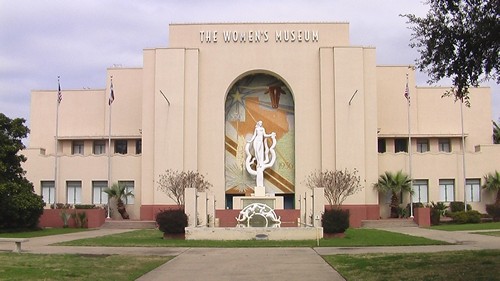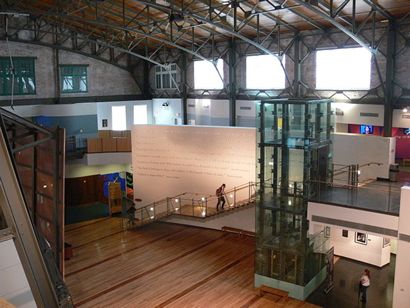|
To
the left of the Founders Statue
lies the former home of the Women's Museum. Construction of the building
began in 1909 at a cost of 108,000 dollars, almost half of it funded
by public donations. Fair Park Coliseum opened a year later
on land that was previously used for baseball games and livestock
events. Originally built for the purpose of hosting horse shows, animal
exhibits, and livestock auctions, the place was designed by architect
James Edward Flanders.
Flanders began his career in Chicago working as an apprentice. He
then moved to Minnesota, but transfered to Dallas
a year later in 1876 because the city desperately needed architects,
thanks to the constant growth it was experiencing. Flanders spent
most of his time designing several of the downtown commercial buildings
and residential projects. After a brief stint in San Diego, California,
he began focusing on churches and schools. During his 55-year career,
he designed over three hundred structures. Most of them were located
in the Dallas area, but he also did work in West Texas, Oklahoma,
California, Arkansas, and Missouri. His most notable works included
the Shackelford
County Courthouse, Navarro
County Courthouse, and Hollywood's Hotel Dupont.
The coliseum that Flanders built had the seating capacity of eight
thousand. Because of its size, the building also hosted musical and
theatrical entertainment, though these events mostly took place at
night while the livestock shows occurred during the day. The stage
was fifty feet long and thirty-six feet wide with twenty-four available
dressing room nearby. This amount of space made the Fair Park Coliseum
a popular place for companies to visit and perform, despite the low-quality
acoustics resulting from the building's spacial design. In addition
to the entertainment and livestock, the place also served as a venue
for car shows and public speeches. The most famous speech was the
one given by Woodrow Wilson in 1911 while campaigning for the Democratic
presidential nomination.
When Fair Park Auditorium,
now called Music
Hall, opened in 1925, the coliseum returned to its beginning roots.
However, it also hosted agricultural exhibits and car shows. In 1935,
in preparation for the centennial celebration, the interior was remodeled
so it could serve as the administration building for the exposition.
George Dahl also gave the order to renovate the exterior.
|
 |
Fair Park Women's
Museum
Photo courtesy Clint Skinner, February 2016 |
|
In front of
the building, Raoul Josset
designed a reflecting pool for Jose Martin to sculpt. The artwork
needed for the pool came in the form of a fountain located in the
back. The fountain depicted a group of fish jumping out of the water
and diving back in. A tall mural and large female statue, together
forming an artwork called Spirit of the Centennial, stood behind
it. The two Frenchmen chose Georgia Carroll to be the model, who
would later become a famous singer for her participation in Kay
Kyser's big band, known as the Kollege of Musical Knowledge. The
twenty-foot statue itself was a nude woman standing on saguaro cactus.
The mural was the work of Italian artist Carlo Ciampaglia. Although
he was born in the boot-shaped nation, Carlo spent his childhood
and artistic training in New York City. He then traveled to Rome
in his native homeland for additional training. He spent most of
his time doing design and decorative work for places such as the
Chapel of the Fairmount Mousoleum, the Sunbury Court House, the
Masonic Temple in Scranton, Pennsylvania, the New York home of David
Milton, and the Food Building of the 1939 New York World's Fair.
The
building fell into a state of disrepair and neglect, which continued
until the Women's Museum took over operations. The museum was the
brainchild of Cathy Bonner. She was in charge of several marketing
and advertising companies, one of them responsible for helping twelve
state programs dealing with college aide. In addition to her business
endeavors, Bonner served former governor Ann Richards by becoming
the executive director of the Texas Department of Commerce and working
to improve the economy. However, this was not the first time that
the two women had worked together.
In 1975, before she got heavily involved with politics, Ann Richards
took her family to San
Antonio to see a special show about the state's history at the
Institute of Texan Cultures. Amazingly, not a single woman was mentioned
throughout the presentation. Richards decided that she would find
out more about the role women played in Texas history. She looked
in textbooks and exhibitions for answers, but came up empty every
time.
Not to be deterred, Richards formed the Texas Foundation for Women's
Resources, which Cathy Bonner joined and became one of the organization's
founders. They started working on their first endeavor and called
it the Texas Women's History Project. With Mary Beth Rogers as the
director and Ruthe Winegarten in charge of research, the members
joined forces with a team of historians, college students, and other
volunteers to find and preserve women's role in Texas history. Five
years after Ann's inspiration, the organization finally accomplished
its goal of presenting a history of Texas Women. The result was
a traveling museum that moved from place to place throughout the
state. Texas Women: A Celebration of History lasted for two
years and can be viewed at the Blagg-Huey Library in Denton.
Cathy came up with the idea for a permanent women's museum in 1996
as a result of a recurring dream. Wanting to make her dream a reality,
she started to look for the place. She contacted an organization
called the Friend of Fair Park, which provided a tour of the grounds.
Bonner took a look at the artistic work known as Spirit of the Centennial
and decided that the building would serve as the perfect host for
the museum. With the help of the Texas Foundation for Women's Resources,
she was able to raise thirty million dollars for the project.
Work on the exterior began in 1998 and included the restoration
of the statue, mural, and pool. Stashka Star handled the centennial
art while conservation expert John Dennis dealt with the fountain.
Wendy Evans Joseph, who worked on the Holocaust Memorial Museum
in the nation's capital, designed the interior. However, the various
exhibits themselves were done by Whirlwind Creative, a company located
in Harrisburg, North Carolina. All the construction was performed
by a local company called F & S Partners.
|
 |
Museum
interior
Photo by Andreas Praefcker* |
|
The Women's
Museum opened as an affiliate of the Smithsonian Institution on
September 29, 2000. A significant portion of the first floor was
composed of open, empty space used for special events, dinners,
and meetings. In addition, the floor had areas dedicated to art
galleries, visiting exhibits, and classrooms for various children's
activities. The second floor hosted a series of historical exhibits
which included displays paying tribute to influential females, a
timeline combining text and memorabilia, and informational videos.
The third floors devoted itself to health-related subjects.
Unfortunately for the museum, it faced a series of financial struggles
caused by a lack of funding. According to records released in 2007,
it had a deficit of 600,000 dollars which doubles the following
year. This number increased to 1,300,000 in 2009. The
continued failure to make a profit led to the decision to close
the Women's Museum in 2011.
Since the closure of the museum, the building has remained empty
and closed throughout the year, except during the state fair when
it is used to host Mundo Latino. It serves as a celebration
of the Latin American cultures throughout Central and South America.
The first floor host a variety of attractions. Along the perimeter,
merchants sell products that are indicative of their home country
and culture. Near the back area, a wooden stage allows a wide range
of live entertainment to take place, most of it coming from local
schools, singers, dancers, and musicians. The floor also displays
historic exhibits that have the tendency to mirror the fair's theme
for the year. The second floor, which is empty for the most part,
hosts a pictorial tribute to those who have fought and died on the
battlefield. The third floor also has a pictorial tribute, but it
focuses on the memories of Little Mexico.
Little
Mexico was a small community located in the downtown area, the first
one to host a fully-Hispanic population. It was located south of
Riverchon Park with McKinney Avenue running along the bottom border,
Maple Avenue serving as the eastern barrier, and Stemmons Freeway
traveling past the left side. Originally settled by Jewish immigrants
from Poland during the 1800s, the neighborhood was flooded by people
seeking refuge from the Mexican Revolution, which started in 1910
and lasted for ten years. During this time, the Jews left the neighborhood
as the Hispanic population continued to grow.
Little Mexico received it name in 1919. The area was a poor, overpopulated
neighborhood with substandard housing, unpaved roads, and no health
care facilities. Some improvements occurred over the years and the
1950s were a time of redevelopment.
The beginning of the end arrived in 1966 with the construction of
the Dallas North Tollway straight through the middle of the neighborhood.
Compounded by Woodall Rodgers Freeway on the southern portion of
the area, Little Mexico had an uphill climb if it wanted to expand.
While this was going on, several businesses wanted to use the area.
Many of the houses were bought and demolished for redevelopment
and the construction of large buildings began. Very little of the
neighborhood still exists, the two major remnants being Pike Park
and the birthplace of nation's oldest Mexican restaurant chain.
El Fenix was started by Miguel Martinez, an immigrant who fled Mexico
to escape from the revolution started by the removal of President
Porfirio Diaz. Miguel opened a restaurant in 1916 and called it
Martinez Café, resulting in the introduction of Tex-Mex cuisine.
Two years later, he changed its name to El Fenix because he believed
in the practice of trying to turn failures into successes. His restaurant
became so successful, he bought the building next door and transformed
it into the El Fenix Ballroom during the 1930s. It featured live
music from an orchestra while patron could enjoy an evening of dancing.
Martinez decided to retire in 1946 and gave the business to his
four sons. Since that time, El Fenix has grown into a full-fledged
chain of restaurants.
September 11, 2016
© Clint
Skinner
*Author's Note:
All the pictures that are not mine are either public domain or creative
commons. I provided the photographer's name.
|
References:
1.Bigtex.com
2.Dallashistory.org
3.Dallas Morning News Archives
4.Fairpark.org
5.Slate, John H. Historic Dallas Parks. Arcadia Publishing, 2010.
6.Tshaonline.org
7.Watermelon-kid.com
8.Wikipedia.org
8.Winters, Willis Cecil. Fair Park. Arcadia Publishing, 2010. |
|
|
| Texas
Escapes, in its purpose to preserve historic, endangered and vanishing
Texas, asks that anyone wishing to share their local history, stories,
landmarks and vintage or recent photos, please contact
us. |
|
|
